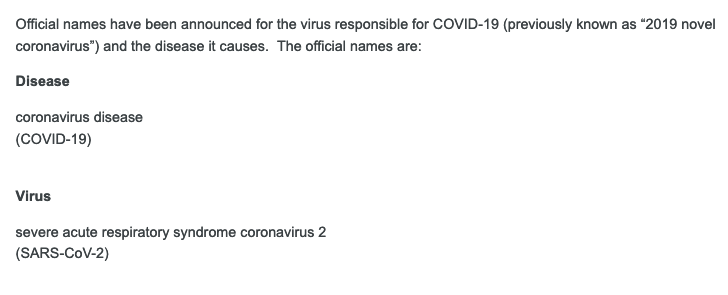Photo by Brian McGowan on Unsplash
In light of the pandemic, health-related misinformation has never been more prevalent, so understanding key terms is important in curbing the spread of misinformation.
The words coronavirus and COVID-19 quickly entered the global vocabulary when the World Health Organisation (WHO) announced an international public health emergency and pandemic in early 2020. In the midst of the ongoing pandemic, chances are, you are hearing and reading the words multiple times a day across media platforms.
Following are commonly misused terms associated with the COVID-19 outbreak.
Coronavirus vs. COVID-19
According to the World Health Organisation (WHO), coronaviruses are:
“… a large family of viruses which may cause illness in animals or humans. In humans, several coronaviruses are known to cause respiratory infections ranging from the common cold to more severe diseases such as Middle East Respiratory Syndrome (MERS) and Severe Acute Respiratory Syndrome (SARS). The most recently discovered coronavirus causes coronavirus disease COVID-19.”
As for COVID-19, the WHO describes it as:
“… the infectious disease caused by the most recently discovered coronavirus. This new virus and disease were unknown before the outbreak began in Wuhan, China, in December 2019.”
COVID-19 is a disease that is caused by a specific coronavirus, namely SARS-CoV-2. Therefore, a patient tests positive for SARS-CoV-2 (virus) infection which causes symptoms of the COVID-19 (disease) – fever, a dry cough, and in severe cases, difficulty in breathing.
For those reporting on the global health crisis, it is thus better or advisable to refer to the COVID-19 pandemic than the coronavirus pandemic.
Isolation vs. Quarantine
With most countries (including Namibia) having implemented lockdown protocols to curb the spread of the COVID-19 disease, it is imperative to understand the difference between isolation and quarantine and which to apply in a given situation. The US’s Centers for Disease Control and Prevention (CDC) give the following definitions for the terms:
“Isolation separates sick people with a contagious disease from people who are not sick.”
This does not require strict supervision, but needs to be adhered to as a preventive measure for a rise in infections. The isolating environment does not have to be a hospital, but rather a considered safe environment that has low chances of contracting the disease or virus in question.
“Quarantine separates and restricts the movement of people who were exposed to a contagious disease to see if they become sick.”
This is usually under strict supervision from health practitioners that have experience with the disease or virus. This is done to monitor the patient’s condition and ensure no contact to the general public in attempts to prevent a further spread of the disease or virus in question.
Pandemic vs. Epidemic
The difference between a pandemic and an epidemic is in the geographical spread of the disease.
An epidemic is when a disease or virus spreads, but is still contained within a specific country or region. A pandemic is over multiple geographical areas such as countries and continents. This means that a certain disease or virus has spread uncontrollably over a large geographical area, such as what COVID-19 has done.
On 12 March 2020, the WHO announced that the COVID-19 disease was a pandemic because it had spread to various countries and became a global public health emergency.
Virus vs. Disease
The terms coronavirus and COVID-19 are used interchangeably by media outlets and even in official press briefings by government. However, the virus and the disease are two different things.
An outbreak of COVID-19 refers to the spread of the disease and an outbreak of coronavirus refers to the spread of the virus. So it is important to distinguish between the two.
For guidance on this, see this WHO post.

WHO explains the need for a distinction in naming between a virus and a disease:
“Viruses, and the diseases they cause, often have different names. For example, HIV is the virus that causes AIDS. Viruses are named based on their genetic structure to facilitate the development of diagnostic tests, vaccines and medicines… Diseases are named to enable discussion on disease prevention, spread, transmissibility, severity and treatment.”

